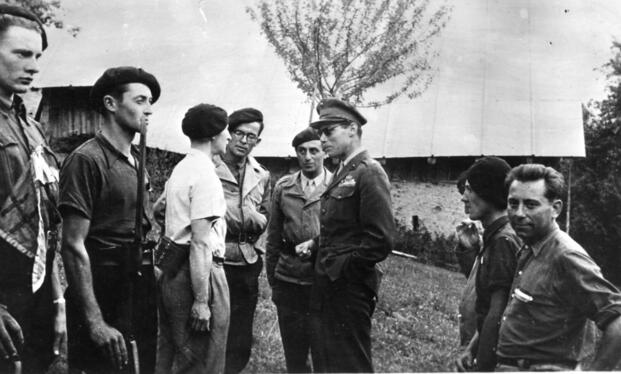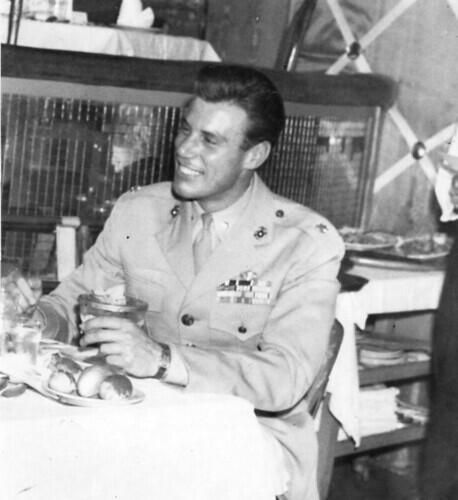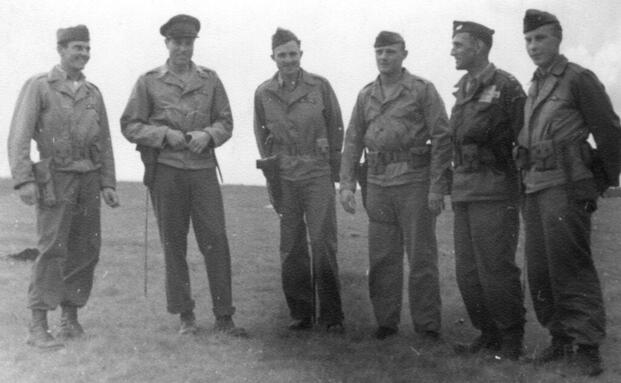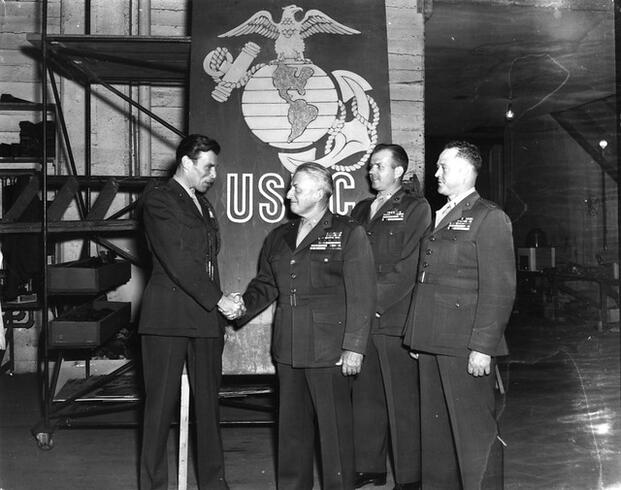Most Marines had never seen combat when Peter Ortiz joined the Corps in June 1942. However, he had already survived five years in the French Foreign Legion and fought in Africa, faced the Nazis in France, spent 15 months as a prisoner of war, and escaped occupied Europe to get back into the fight.
Before the war ended, the New York-born Legionnaire would become the most decorated member of the Office of Strategic Services and one of the most decorated Marines of World War II.
From New York City to the French Foreign Legion
Born July 5, 1913, Ortiz was raised in affluence as the son of Philippe Ortiz, a French-Spanish art dealer, and his mother Marie Louise. His parents separated when he was young, and he lived with his socially connected mother. After being educated at the University of Grenoble in France, where he became fluent in ten languages including French, German, Arabic, Italian and Portuguese, he made a choice at 19 that shocked his wealthy family.
In February 1932, Ortiz joined the French Foreign Legion. He was sent first to the Legion’s brutal training camp at Sidi Bel-Abbes in Algeria, training designed to break recruits physically and mentally. Ortiz didn’t just survive it—he excelled. After this, he was assigned to Morocco with the 3rd Machine Gun Company of the 2nd REI.
He fought against Rif rebels in Morocco, earning two Croix de Guerre for his actions in combat. After meeting Ortiz, British journalist George Ward Price would write: “This distinguished-looking young American would have made an officer of whom any army in the world would have been proud.”
Ortiz rose quickly through the ranks—corporal in 1933, sergeant in 1935. He became the youngest sergeant in Legion history at the time and was offered both a commission and French citizenship. He declined both. When his five-year enlistment ended in 1937, he returned to California, where he worked as a technical adviser on war films.
Wounded, Captured and His Escape Behind Enemy Lines
When Germany invaded Poland in September 1939, Ortiz re-enlisted in the French Foreign Legion. In May 1940, during the Battle of France, he received a battlefield commission to lieutenant. Weeks later, he was shot in the hip while blowing up a German fuel depot. Wounded and attempting to escape on a stolen motorcycle, the Germans captured him.
For the next 15 months, Ortiz moved between POW camps in Germany, Austria and Poland. He attempted to escape five times before finally succeeding in October 1941. His fluency in multiple European languages helped—he stayed with his father in Paris before slipping across the border into neutral Spain. He then made his way to Portugal, then sailed back to the United States.
Just before his ship made it to New York, he learned of the Japanese Bombing of Pearl Harbor. The U.S. Army Air Corps promised him a commission but the paperwork moved too slowly for his liking. On June 22, 1942, he enlisted in the Marine Corps as a private. His military file immediately stood out from other recruits.
One senior Marine officer wrote that “the rather unique experiences and qualifications of Lieutenant Ortiz indicate that he would be of exceptional value to American units operating in North Africa.”
After just 40 days of service—much of it spent as an assistant training officer at Parris Island—Private Ortiz became Second Lt. Ortiz. By December, he had been promoted to captain, skipping first lieutenant entirely. He was assigned to the 23rd Marines at Camp Lejeune before receiving orders for Morocco.

Behind Enemy Lines in North Africa
On Dec. 21, 1942, Capt. Ortiz flew to North Africa, officially as an assistant naval attaché and Marine Corps observer stationed in Algiers. As part of the OSS, he was actually tasked with organizing local resistance to conduct reconnaissance and gather intelligence behind Axis lines.
In January 1943, during a nighttime reconnaissance patrol in Tunisia, Ortiz and his men ran into a German patrol. In what was described as a “fierce firefight,” Ortiz was severely wounded in the right hand. Despite the injury, he continued throwing grenades, forcing the Germans to withdraw. Ortiz was evacuated to a hospital in Algiers, then flown home to the U.S. to recover.
Gen. William Donovan, director of the OSS, received a message from Algiers stating: “Peter Ortiz, U.S.M.C.R. was severely wounded in the right hand while engaged in a personal encounter with a German patrol. He dispersed the patrol with grenades.”
Donovan read Ortiz’s after-action report and wrote over it: “Very interesting, please re-employ this man as soon as possible.”

Operation Union: Parachuting Into Occupied France
After recovering in Washington in early May 1943, Ortiz was reassigned to the OSS Naval Command. He became one of only 80 Marine Corps officers to serve with the OSS during WWII. Transferred to London in July, he received orders for his most dangerous assignment yet.
On the night of Jan. 6, 1944, Ortiz parachuted from a Royal Air Force bomber into the Haute-Savoie region of German-occupied France. He jumped as part of Operation Union, a three-man team that included British Col. H.H.A. Thackwaite from the Special Operations Executive and French radio operator Andre “Monnier” Foucault. Their mission was to assess the military capabilities of Maquis resistance units in the region and organize them prior to D-Day.
The team jumped in civilian clothes—aware they could be executed as spies if captured—but carried their uniforms with them. After linking up with resistance fighters, they changed into uniform to demonstrate this was an official military operation. Ortiz posed as a Parisian fashion designer to avoid suspicion when moving in civilian clothes.
Still being a Marine though, he chose to constantly wear his duty uniform, complete with ribbons and medals. Thackthwaite later wrote, “Ortiz, who knew not fear, did not hesitate to wear his U.S. Marine captain’s uniform in town and country alike; this cheered the French but alerted the Germans, and the mission was constantly on the move.”
For five months, the team worked to unify the resistance groups, arranged airdrops of weapons and ammunition, and led raids against German positions. Ortiz proved his value repeatedly, even going as far as organizing hospitals and safe-houses for the resistance, procuring supplies from the Allies, and even securing stipends for the families of fallen resistance members.
He even earned the Order of the British Empire by breaking into a Gestapo garage, stealing a vehicle and a Gestapo pass, despite the Germans actively hunting him. He then drove four downed Royal Air Force pilots through Vichy France to the Spanish border, then returned to continue his mission.
Operation Union ended on May 20, 1944, when the team was airlifted back to England. Ortiz was promoted to major and received his first Navy Cross for his extraordinary heroism behind enemy lines.

Toasting Roosevelt at Gunpoint
It was during Operation Union that one of Ortiz’s most famous incidents occurred. German officers from the 157th Division—who were actively hunting the Marine and his resistance contacts—were drinking in a club. They allegedly began loudly cursing the “tall American Marine,” President Franklin Roosevelt and even the U.S. Marine Corps.
Ortiz, sitting nearby in civilian clothes, did not take that lightly. He left the bar, returned to his safe house, and put on his Marine Corps service uniform—complete with all his American and French decorations. He threw a raincoat over the uniform, holstered two Colt Model 1911 .45-caliber pistols, and walked back to the club.
He approached the German officers and ordered drinks for them. Then he removed his raincoat to reveal his Marine Corps uniform and drew his pistols on the stunned Nazi officers.
“A toast to the president of the United States,” he allegedly said.
The Germans raised their glasses and drank. Ortiz ordered another round.
“A toast, to the Marine Corps.”
The officers drank again. Some accounts claim Ortiz then shot and killed the officers. Ortiz later claimed he escaped without killing anyone—he wanted them to live and spread the story.
While the story has been debated, multiple accounts confirm Ortiz carried his Marine uniform during his missions in France. Maquis leader Raymond Bertand even photographed Ortiz in his service uniform during this time.

Operation Union II: Surrendering to Save a Village
On Aug. 1, 1944, Maj. Ortiz returned to France for Operation Union II. This time he commanded his own team: five Marine noncommissioned officers—Gunnery Sgt. Robert LaSalle, and Sgts. Charles Perry, John Bodnar, Fred Brunner and Jack Risler—along with Army Air Force Capt. Francis L. Coolidge and Joseph Arcelin, a Free French officer carrying papers identifying him as a Marine.
During the parachute insertion into the French Alps, Sgt. Perry died when his parachute failed to open properly. Another Marine was severely injured on landing and had to be evacuated. Despite these losses, Ortiz pushed forward with his remaining men.
For two weeks, the team conducted sabotage operations and direct action raids against German forces retreating from southern France toward Germany. To boost morale among French civilians, the team moved openly in their Marine uniforms.
On Aug. 16, 1944, while passing through the village of Centron, the team was ambushed by a German convoy. A firefight erupted, but the Americans were surrounded. German Maj. Kolb believed he faced a company-sized unit—at least 100 men.
Ortiz knew the Germans had liquidated entire towns for harboring resistance fighters. French civilians begged the Americans to surrender to prevent reprisals. Ortiz made a drastic decision. He approached the German lines under a flag of truce and negotiated directly with Maj. Kolb.
Ortiz offered to surrender his “entire garrison” if Kolb gave his word the villagers would not be harmed. Kolb agreed.
When only Ortiz, Sgt. Bodnar and Sgt. Risler walked out of the village, the Germans were shocked. Kolb was furious when he realized only three Marines had held off a German battalion. But Kolb kept his word. The people of Centron lived.
His second Navy Cross citation noted that despite being imprisoned and subjected to numerous interrogations, Ortiz divulged nothing. It also stated that “the story of this intrepid Marine Major and his team became a brilliant legend in that section of France where acts of bravery were considered commonplace.”

End of the War and Final Captivity
Ortiz spent the remainder of the war as a prisoner. He was shuttled between POW camps in northern Germany, where German officers treated him as a regular prisoner rather than a commando—possibly because Maj. Kolb had shielded him from the SS.
Ortiz made multiple escape attempts while imprisoned. On Dec. 18, 1944, he and Navy Lt. Hiram Harris cut through wire fences at a POW camp near Bremen and reached the woods. The men were captured; Ortiz was beaten and placed in solitary confinement.
In April 1945, with the Allies closing in, Ortiz and his fellow prisoners were moved to another camp. During the march, RAF Spitfires attacked the column. In the chaos, Ortiz escaped with two Americans and one British prisoner. They hid in the woods for ten days, hoping to be rescued by Allied troops. Starving, they were forced to return to the camp they’d been held in, looking for food.
When they entered the camp, they discovered the prisoners had taken control. On April 29, 1945, the British 7th Guards Armored Division liberated them. Ortiz was reunited with the Marines from his OSS team.

Hollywood, Arlington and Legend
Ortiz was discharged from active duty in 1946 but remained in the Marine Corps Reserve, finally retiring on March 1, 1955, with promotion to colonel on the retired list. He even volunteered to return to the Corps to serve as an advisor in Indochina, but this was denied.
He returned to Hollywood and resumed his film career, forming a friendship with director John Ford, who had also served with the OSS. Ortiz appeared in several Ford films, including Rio Grande in 1950 and The Wings of Eagles in 1957, both starring John Wayne.

Two films were based on his wartime exploits: 13 Rue Madeleine in 1947 starring James Cagney, and Operation Secret in 1952. Ortiz served as technical adviser on both but had little input on the scripts. He later told columnist Bob Thomas: “They had stipulated that I was to help in the screenplay but never consulted me.”
His son, Marine Lt. Col. Peter J. Ortiz Jr., summed up his father’s acting career simply: “My father was an awful actor but he had great fun appearing in movies.”
Ortiz married his sweetheart, Jean Morlan, in 1948. They eventually settled in Arizona, where Ortiz pursued interests in art, history, religion and filmmaking while raising their son.
Peter Ortiz died of cancer on May 16, 1988, at the Veterans Medical Center in Prescott, Arizona. He was 74 years old. He was buried with full military honors at Arlington National Cemetery. Representatives from the British and French governments attended the ceremony, alongside his former comrades Bodnar and Risler.
His decorations from three countries included two Navy Crosses, a Legion of Merit with Valor device, an Order of the British Empire, two Purple Hearts, five Croix de Guerre, and numerous other American and French awards.
In August 1994, the village of Centron held a ceremony to rename the town center Place Peter Ortiz. His widow Jean, his son Pete Jr., and Sgts. Bodnar and Risler attended. A plaque now hangs in the mayor’s office commemorating the Marine who surrendered to save their town.
He was the most decorated OSS agent of WWII. Marine historian Benis Frank later wrote: “Peter Julien Ortiz was a man among men. It is doubtful that his kind has been seen since his time.”
Story Continues
Read the full article here





